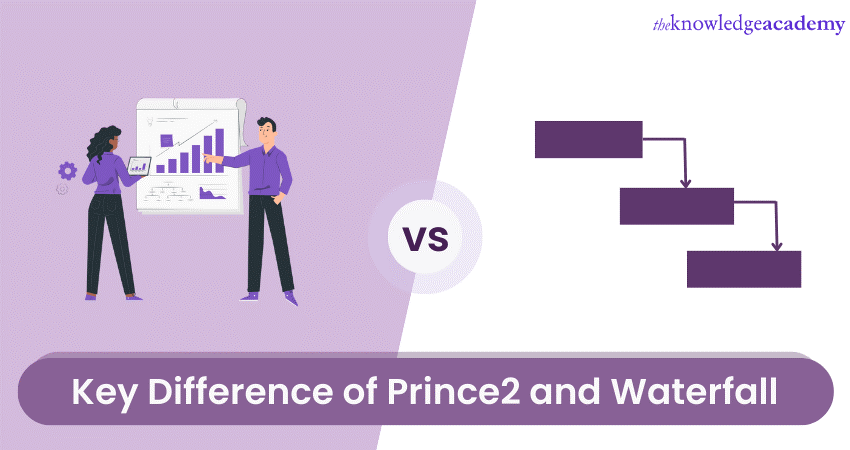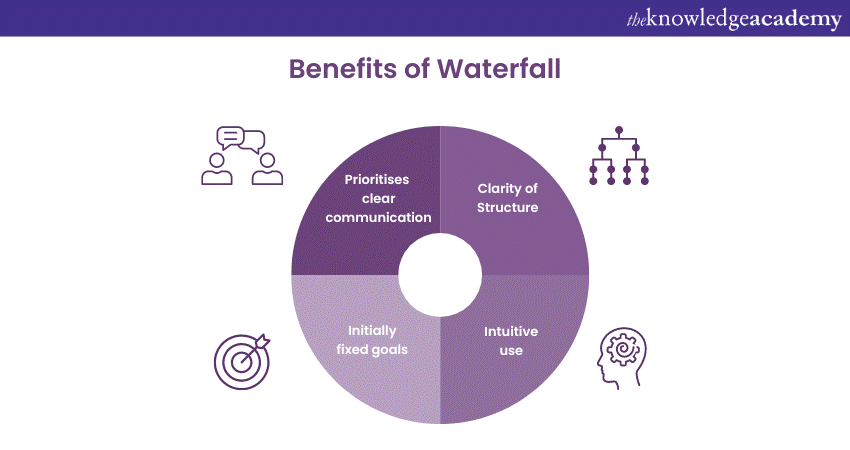We may not have the course you’re looking for. If you enquire or give us a call on 01344203999 and speak to our training experts, we may still be able to help with your training requirements.
Training Outcomes Within Your Budget!
We ensure quality, budget-alignment, and timely delivery by our expert instructors.

Technological innovations have helped simplify the process of completing projects and developing software. PRojects IN Controlled Environments (PRINCE2) and Waterfall is a project management methodology and development approach that provides efficient and favourable results.
According to Finances Online, organisations using project management methodologies waste 28 times fewer funds than organisations which do not and 46% of organisations acknowledge the value of project management. Thus, methodologies like PRINCE2 and Waterfall are essential in the project management field. PRINCE2 is also known as the waterfall method. In this blog, you will learn the key differences between them.
Table of Contents
1) PRINCE2 – an overview
2) Waterfall – an overview
3) Key Difference between PRINCE2 and Waterfall
4) Conclusion
PRINCE2 – An Overview
One widely used project management methodology - PRINCE2- helps organisations complete projects efficiently. It divides a project into manageable parts and establishes the PRINCE2 Roles and Responsibilities of team members in each stage.
The PRINCE2 method was sourced from the Project Resource Organisation Management Planning Technique (PROMPT) in 1975. The main components of the PRINCE2 methodology include the PRINCE2 principles, aspects, and processes.
The PRINCE2 Principles are essential factors that must be considered at every project stage. The principles act as a part of the foundation of the PRINCE2 methodology. Here are the seven principles of PRINCE2:
a) Continued business justification
b) Learn from experience
c) Defined roles and responsibilities
d) Manage by stages
e) Manage by exception
f) Focus on products
g) Tailor to suit the project environment
The aspects of PRICNE2 are the areas that must be managed in every stage of every project. Here are the six PRINCE2 Aspects:
a) Scope
b) Cost
c) Timescales
d) Risk
e) Quality
f) Benefits
Learn about the best project management principles, themes, and processes by signing up for our PRINCE2® Training courses now!
PRINCE2: Benefits
PRINCE2 is a well-known project management methodology that can benefit businesses in multiple ways. Following are some of the benefits of using PRINCE2 for projects:
a) Trusted Methodology: PRINCE2 is a globally recognised project management methodology that provides a reliable framework. Multiple organisations still recommend it because it offers better project control and enhances visibility.
b) Can be combined: One of the most significant advantages of using PRINCE2 is its ability to work with other methods. It can be combined with parts of different project management methodologies, resulting in you reaping both benefits.
c) Flexibility: The PRINCE2 methodology is extremely flexible as it can be tailored to fit the objectives of different projects from different industries.
d) Continuous Improvement: Teams adopting PRINCE2 prioritise the need to improve at every PRINCE2 Project Stage, especially in the initial and ending stages. They evaluate the project completion process and identify areas that can be enhanced for better projects in the future.
Waterfall – An Overview
Waterfall refers to the Software Development Life Cycle (SDLC) approach. Project managers commonly use this model to accomplish their project goals in industries like Information Technology (IT), manufacturing, software development, etc.
The term 'Waterfall' was coined due to the model's resemblance to how waterfalls look. This model is designed linearly, such that the outcome of each step is based on the output of the step before it. This implies that each phase can only truly begin when the previous one ends.
One of the essential features of the this method is that it does not incorporate the changes suggested after the project's initial phase. Feedback from users is appreciated at the beginning of the project, and they are implemented soon after.
Once the team is well-versed in the user's requirements, the development team starts designing the software. After building the system, it is tested to check if it works and to identify any faults that can be fixed. Developers debug the system and install and maintain the software for the customer.
Acquire a PRINCE2 certification to learn about the methodology in detail by signing up for our PRINCE2® Foundation & Practitioner Training course now!
Waterfall: Benefits

The Waterfall model progresses linearly and sequentially, resulting in a simple structure to follow. There are more advantages of this development approach which makes it a commonly used structure. The following are some benefits of using the Waterfall methodology:
a) Clarity of structure: It comprises clear and concise steps that illustrate the responsibilities at every step in detail. Such projects go through various stages – requirements, design, implementation, deployment, and maintenance phases.
b) Intuitive use: Using this model as a project management methodology does not require much preparation time. The use of a Waterfall is primarily intuitive. Visualising the process at the beginning can help teams easily follow the Waterfall model.
c) Initially fixed goals: This model encourages the project's end goal to be established early. This way, the team can avoid minor confusion as the project progresses.
d) Prioritises clear communication: The methodical structure of the Waterfall model indicates the importance of clear communication. At every step of the project, it is made sure that each new member is made aware of all the project details.

Key Difference Between PRINCE2 and Waterfall
The significant difference between the PRINCE2 and the Waterfall methodology is that PRINCE2 is a project management methodology while Waterfall is a development approach. They also have different processes or phases.
Another difference between the PRINCE2 methodology and the Waterfall approach lies in the phases or processes they follow. Let's look at the processes of PRINCE2 in detail. There are seven processes in PRINCE2 which help to manage projects:
a) Start up the project: The start of the project is marked by the request to start a new project, known as a project mandate. The organisation assesses the mandate to check the project's feasibility, followed by its approval or rejection.
b) Initiate the project: The project is initiated with a document that states the project's objectives, estimated cost, benefits, potential risks, and more.
c) Direct the project: The document created in the previous step is reviewed by the board for approval. They analyse the project's benefits and, based on their observations, state their decisions on authorising it.
d) Control stages: The control stage is where the PRINCE2 Project Manager gets the busiest. They are required to assign tasks to team members and solve all issues and conflicts that show up at various stages. This is also the stage where the Project Manager has to track the project's progress.
e) Manage product delivery: This stage refers to the activities that ensure the proper delivery of the product.
f) Manage stage boundary: Managing the stage boundary comprises two stages. The first stage is where the Project Manager updates the project board with their observations on the project, its progress report, etc. The second stage refers to the board evaluating the data presented by the Project Manager to help them make better decisions regarding the next stage.
g) Close the project: The final process in PRINCE2 involves checking whether the project has successfully achieved its objectives in time.
Like the PRINCE2 processes, the Waterfall model consists of seven stages or phases. The phases are placed in a sequential design process. Here are the seven stages of a Waterfall model for software development:
a) Requirements: The requirements stage is the most important stage of the project. This stage can be considered the planning stage because the outline of the project is drawn without specifying any processes.
It usually includes flow diagrams that map out the responsibilities of the team members alongside the preferred timeline. The project plan in the requirements phase must consist of an outline of every process phase, the team members working at each stage, resources, and the timeline.
b) Analysis: Once the requirements are established, they are analysed to determine their overall feasibility. The information obtained here enables the authorities to make the right decision and optimise how the project is managed, leading to success.
c) Design: The design stage is when requirements like programming languages and hardware are documented. It comprises two steps – the high-level and low-level design phases.
The high-level design phase is where an outline of the design and functioning of the software is created, while the low-level design phase includes a more detailed approach to software development.
d) Coding and implementation: The product model, logic, and design requirements create the source code. It is the phase where the software development process is initiated.
e) Testing: As the term suggests, this stage is when the product undergoes testing to identify areas of error. The Quality Assurance (QA) team checks the software for bugs and fixes them if found. Quality assurance, system, and bets tests are a few of the tests that reveal the troubled parts of the product.
Operation and deployment: This stage marks the product's complete development and is released to the end user. It is the phase where the product is launched in public.
Maintenance: The product is continuously upgraded to improve the product in multiple aspects. Sometimes, bugs might be detected after the product launch, needing an update. The upgrade can also come in the form of patch updates or new versions.
Conclusion
Both PRINCE2 and Waterfall are project management methodologies that are used to promote the smooth functioning of projects. Although they are similar, there is a significant difference between their themes of prince2 and processes. We hope this blog has helped you learn more about the methodologies and their critical differences.
Learn about the basics of project management with PRINCE2 and Agile. Sign up for our PRINCE2 Agile® Foundation And Practitioner course now!
Frequently Asked Questions
Upcoming Project Management Resources Batches & Dates
Date
 PRINCE2® Foundation & Practitioner Training Course
PRINCE2® Foundation & Practitioner Training Course
Tue 7th May 2024
Sat 11th May 2024, Sun 12th May 2024
Mon 13th May 2024
Mon 20th May 2024
Sat 25th May 2024, Sun 26th May 2024
Tue 28th May 2024
Mon 3rd Jun 2024
Sat 8th Jun 2024, Sun 9th Jun 2024
Mon 10th Jun 2024
Mon 17th Jun 2024
Sat 22nd Jun 2024, Sun 23rd Jun 2024
Mon 24th Jun 2024
Mon 1st Jul 2024
Sat 6th Jul 2024, Sun 7th Jul 2024
Mon 8th Jul 2024
Mon 15th Jul 2024
Sat 20th Jul 2024, Sun 21st Jul 2024
Mon 22nd Jul 2024
Mon 29th Jul 2024
Sat 3rd Aug 2024, Sun 4th Aug 2024
Mon 5th Aug 2024
Mon 12th Aug 2024
Sat 17th Aug 2024, Sun 18th Aug 2024
Mon 19th Aug 2024
Tue 27th Aug 2024
Sat 31st Aug 2024, Sun 1st Sep 2024
Mon 2nd Sep 2024
Mon 9th Sep 2024
Sat 14th Sep 2024, Sun 15th Sep 2024
Mon 16th Sep 2024
Mon 23rd Sep 2024
Sat 28th Sep 2024, Sun 29th Sep 2024
Mon 30th Sep 2024
Mon 7th Oct 2024
Sat 12th Oct 2024, Sun 13th Oct 2024
Mon 14th Oct 2024
Mon 21st Oct 2024
Sat 26th Oct 2024, Sun 27th Oct 2024
Mon 28th Oct 2024
Mon 4th Nov 2024
Sat 9th Nov 2024, Sun 10th Nov 2024
Mon 11th Nov 2024
Mon 18th Nov 2024
Sat 23rd Nov 2024, Sun 24th Nov 2024
Mon 25th Nov 2024
Mon 2nd Dec 2024
Sat 7th Dec 2024, Sun 8th Dec 2024
Mon 9th Dec 2024
Mon 16th Dec 2024







 Top Rated Course
Top Rated Course


 If you wish to make any changes to your course, please
If you wish to make any changes to your course, please


